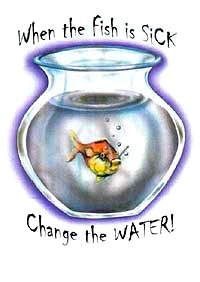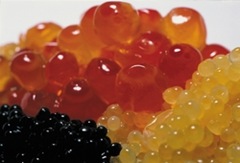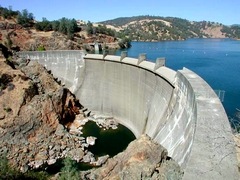 I’d just finished another hallway conversation wherein I defended myself, the rest of you louts, and our beloved pastime. I was fumbling for the file to notch my “gunbutt” with another eco-radical kill, when I was brought up short…
I’d just finished another hallway conversation wherein I defended myself, the rest of you louts, and our beloved pastime. I was fumbling for the file to notch my “gunbutt” with another eco-radical kill, when I was brought up short…
It was innocent piece, really – but it cited a statistic that fascinated me:
Each year, more than 12,000 tons of rubbery “soft baits” land at the bottom of lakes, streams and rivers, says Hobbins, who is president and CEO of Waunakee-based Lake Resources Group.
An enterprising lad has devised a new “plastic worm” that resists tearing, doesn’t come off the hook, and lays claim to the ecological “high ground” for low impact artificial baits.
My snappy comeback failed, I’m thinking it has to have TransFat in there somewhere. The old adage of “..if it feels good or tastes good it’s bad for you” leaps to mind, especially for a tactile yummy like a gelatinous worm.
Thankfully we don’t have a similar statistic for lost flies, but it has to be right up there in gross tonnage. I’m discounting the lead split shot, as we’re already drinking a couple hundred years worth compliments of duck hunters.
I’m guessing our lost tackle is nearly two-thirds the worm total, a lot of our flies are smaller and weigh less, many weigh more, but they wouldn’t be representative of the “average” fly. Tyer’s like me and Daytripper tip the balance, as we’re more comfortable throwing leaden death than the gossamer stuff, even so – 8000 tons of flies wedged in rocks and tree limbs is a economy stimulating total.
As this is a “per season” weight can we turn this into a lucrative profession? Scuba gear is expensive, but there’s a thriving industry recovering sunken golf balls – why not flies?
I’m leaning toward one of those Montana trophy streams – I can lay in wait behind the big rock and pluck stoneflies nymphs off your leader like dollar bills – so long as I give you a couple tugs you’re happy, you’re just going to lie about it anyway’s…
Technorati Tags: plastic worms, tackle loss, sunken limb
 Brownlining is fine, but I’ve got to draw the line somewhere. Fishing anywhere in Northern California would be best described as “Brown Lunging” regardless of elevation and venue.
Brownlining is fine, but I’ve got to draw the line somewhere. Fishing anywhere in Northern California would be best described as “Brown Lunging” regardless of elevation and venue.
 Politics makes strange bedfellows and with declining participation in out-of-doors activities you can expect change. The Sierra Club is appealing to the sporting fraternity with it’s launch of the
Politics makes strange bedfellows and with declining participation in out-of-doors activities you can expect change. The Sierra Club is appealing to the sporting fraternity with it’s launch of the  It’s the best advice I’ve seen to date and based on our track record would work swimmingly, the downside is you’d have to develop a taste for Zebra Mussel Meatloaf, or Quagga Milkshake.
It’s the best advice I’ve seen to date and based on our track record would work swimmingly, the downside is you’d have to develop a taste for Zebra Mussel Meatloaf, or Quagga Milkshake. We tuned them out once we heard the “lecture” tone, some old SOB wanted to tell us how it’s done, as if he knew anything. Maturity does have value,
We tuned them out once we heard the “lecture” tone, some old SOB wanted to tell us how it’s done, as if he knew anything. Maturity does have value,  I figured carp and bass would still be plentiful and assumed I could move to Canada before they close the borders.
I figured carp and bass would still be plentiful and assumed I could move to Canada before they close the borders.  A
A  I always thought there were only two kinds of fish, those worth throwing flies at – and bait. “Bait” is a slim category as us hardened Californians pride ourselves on being culinary “shock troops” – we gleefully ingest gastronomic foibles, delicacies, and taboo, which doesn’t leave much in the way of undesirable chow.
I always thought there were only two kinds of fish, those worth throwing flies at – and bait. “Bait” is a slim category as us hardened Californians pride ourselves on being culinary “shock troops” – we gleefully ingest gastronomic foibles, delicacies, and taboo, which doesn’t leave much in the way of undesirable chow. I go to the doctor with assorted ailments and he prescribes I eat a carp a day and call him in the morning?
I go to the doctor with assorted ailments and he prescribes I eat a carp a day and call him in the morning? I’d just finished another hallway conversation wherein I defended myself, the rest of you louts, and our beloved pastime. I was fumbling for the file to notch my “gunbutt” with another eco-radical kill, when I was brought up short…
I’d just finished another hallway conversation wherein I defended myself, the rest of you louts, and our beloved pastime. I was fumbling for the file to notch my “gunbutt” with another eco-radical kill, when I was brought up short… It sure looks like migratory fish are the new growth industry for the legal profession, another lawsuit filed here in California seeks the elimination of two aging dams on the Yuba River.
It sure looks like migratory fish are the new growth industry for the legal profession, another lawsuit filed here in California seeks the elimination of two aging dams on the Yuba River.